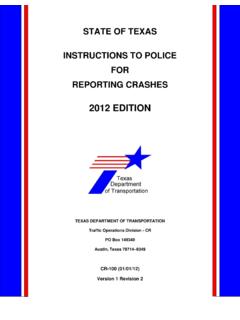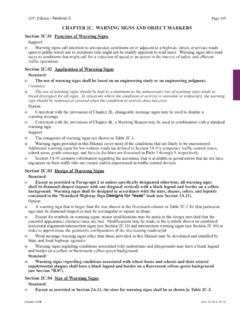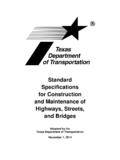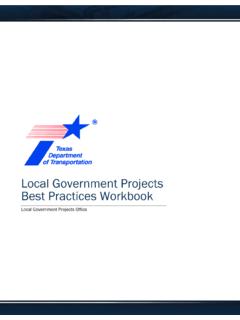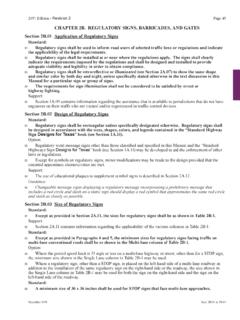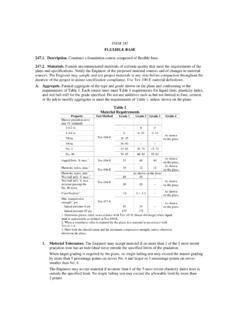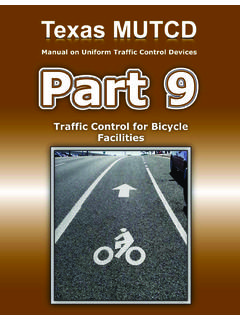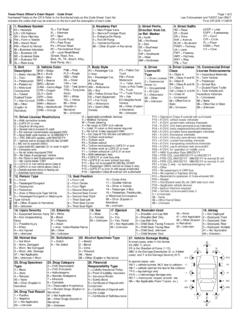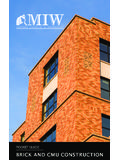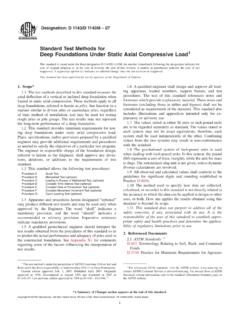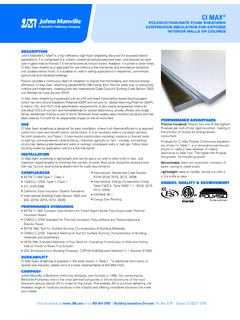Transcription of Item 247 Flexible Base - ftp.dot.state.tx.us
1 247 1 Item 247 Flexible base 1. DESCRIPTION Construct a foundation course composed of Flexible base . 2. MATERIALS Furnish uncontaminated materials of uniform quality that meet the requirements of the plans and specifications. Notify the Engineer of the proposed material sources and of changes to material sources. The Engineer may sample and test project materials at any time before compaction throughout the duration of the project to assure specification compliance. Use Tex-100-E material definitions. Aggregate. Furnish aggregate of the type and grade shown on the plans and meeting the requirements of Table 1. Each source must meet Table 1 requirements for liquid limit, plasticity index, and wet ball mill for the grade specified. Do not use additives, such as but not limited to lime, cement, or fly ash to modify aggregates to meet the requirements of Table 1 unless shown on the plans.
2 Table 1 Material Requirements Material Tolerances. The Engineer may accept material if no more than 1 of the 5 most recent gradation tests has an individual sieve outside the specified limits of the gradation. Property Test Method Grade 1 2 Grade 3 Grade 42 Grade 5 Sampling Tex-400-A Master gradation sieve size (cumulative % retained) Tex-110-E 2-1/2" 0 0 As shown on the plans 0 1-3/4" 0 10 0 10 0 5 7/8" 10 35 10 35 3/8" 30 65 35 65 #4 45 75 45 75 45 75 #40 65 90 50 85 70 90 Liquid Limit, % Max Tex-104-E 40 40 As shown on the plans 35 Plasticity Index, Max1 Tex-106-E 10 12 As shown on the plans 10 Plasticity index, Min1 As shown on the plans As shown on the plans As shown on the plans As shown on the plans Wet ball mill, % Max Tex-116-E 40 As shown on the plans 40 Wet ball mill, % Max increase passing the #40 sieve 20 As shown on the plans 20 Min compressive strength, psi Tex-117-E As shown on the plans lateral pressure 0 psi 35 lateral pressure 3 psi 90 lateral pressure 15 psi 175 175 1.
3 Determine plastic index in accordance with Tex-107-E (linear shrinkage) when liquid limit is unattainable as defined in Tex-104-E. 2. Grade 4 may be further designated as Grade 4A, Grade 4B, etc. 247 2 When target grading is required by the plans, no single failing test may exceed the master grading by more than 5 percentage points on sieves No. 4 and larger or 3 percentage points on sieves smaller than No. 4. The Engineer may accept material if no more than 1 of the 5 most recent plasticity index tests is outside the specified limit. No single failing test may exceed the allowable limit by more than 2 points. Material Types. Do not use fillers or binders unless approved. Furnish the type specified on the plans in accordance with the following: Type A. Crushed stone produced and graded from oversize quarried aggregate that originates from a single, naturally occurring source.
4 Do not use gravel or multiple sources. Type B. Crushed or uncrushed gravel. Blending of 2 or more sources is allowed. Type C. Crushed gravel with a minimum of 60% of the particles retained on a No. 4 sieve with 2 or more crushed faces as determined by Tex-460-A, Part I. Blending of 2 or more sources is allowed. Type D. Type A material or crushed concrete. Crushed concrete containing gravel will be considered Type D material. Crushed concrete must meet the requirements in Section , Recycled Material (Including Crushed Concrete) Requirements, and be managed in a way to provide for uniform quality. The Engineer may require separate dedicated stockpiles in order to verify compliance. Type E. Caliche, iron ore or as otherwise shown on the plans. Recycled Material. Reclaimed asphalt pavement (RAP) and other recycled materials may be used when shown on the plans.
5 Request approval to blend 2 or more sources of recycled materials. Limits on Percentage. Do not exceed 20% RAP by weight, when RAP is allowed, unless otherwise shown on the plans. The percentage limitations for other recycled materials will be as shown on the plans. Recycled Material (Including Crushed Concrete) Requirements. Contractor-Furnished Recycled Materials. Provide recycled materials, other than RAP, that have a maximum sulfate content of 3,000 ppm when tested in accordance with Tex-145-E. When the Contractor furnishes the recycled materials, including crushed concrete, the final product will be subject to the requirements of Table 1 for the grade specified. Certify compliance with DMS-11000, Evaluating and Using Nonhazardous Recyclable Materials Guidelines, for Contractor furnished recycled materials. In addition, recycled materials must be free from reinforcing steel and other objectionable material and have at most deleterious material when tested in accordance with Tex-413-A.
6 For RAP, do not exceed a maximum percent loss from decantation of when tested in accordance with Tex-406-A. Test RAP without removing the asphalt. Department-Furnished Required Recycled Materials. When the Department furnishes and requires the use of recycled materials, unless otherwise shown on the plans: Department-required recycled material will not be subject to the requirements in Table 1, Contractor-furnished materials are subject to the requirements in Table 1 and this Item, the final product, blended, will be subject to the requirements in Table 1, and for final product, unblended (100% Department-furnished required recycled material), the liquid limit, plasticity index, wet ball mill, and compressive strength is waived. Crush Department-furnished RAP so that 100% passes the 2 in. sieve. The Contractor is responsible for uniformly blending to meet the percentage required.
7 247 3 Department-Furnished and Allowed Recycled Materials. When the Department furnishes and allows the use of recycled materials or allows the Contractor to furnish recycled materials, the final blended product is subject to the requirements of Table 1 and the plans. Recycled Material Sources. Department-owned recycled material is available to the Contractor only when shown on the plans. Return unused Department-owned recycled materials to the Department stockpile location designated by the Engineer unless otherwise shown on the plans. The use of Contractor-owned recycled materials is allowed when shown on the plans. Contractor-owned surplus recycled materials remain the property of the Contractor. Remove Contractor-owned recycled materials from the project and dispose of them in accordance with federal, state, and local regulations before project acceptance.
8 Do not intermingle Contractor-owned recycled material with Department-owned recycled material unless approved. Water. Furnish water free of industrial wastes and other objectionable matter. Material Sources. Expose the vertical faces of all strata of material proposed for use when non-commercial sources are used. Secure and process the material by successive vertical cuts extending through all exposed strata, when directed. 3. EQUIPMENT Provide machinery, tools, and equipment necessary for proper execution of the work. Provide rollers in accordance with Item 210, Rolling. Provide proof rollers in accordance with Item 216, Proof Rolling, when required. When ride quality measurement is required, provide a high speed or lightweight inertial profiler certified at the Texas A&M Transportation Institute. Provide equipment certification documentation.
9 Display a current decal on the equipment indicating the certification expiration date. 4. CONSTRUCTION Construct each layer uniformly, free of loose or segregated areas, and with the required density and moisture content. Provide a smooth surface that conforms to the typical sections, lines, and grades shown on the plans or as directed. Stockpile base material temporarily at an approved location before delivery to the roadway. Build stockpiles in layers no greater than 2 ft. thick. Stockpiles must have a total height between 10 and 16 ft. unless otherwise approved. After construction and acceptance of the stockpile, loading from the stockpile for delivery is allowed. Load by making successive vertical cuts through the entire depth of the stockpile. Do not add or remove material from temporary stockpiles that require sampling and testing before delivery unless otherwise approved.
10 Charges for additional sampling and testing required as a result of adding or removing material will be deducted from the Contractor s estimates. Haul approved Flexible base in clean trucks. Deliver the required quantity to each 100-ft. station or designated stockpile site as shown on the plans. Prepare stockpile sites as directed. When delivery is to the 100-ft. station, manipulate in accordance with the applicable Items. Preparation of Subgrade or Existing base . Remove or scarify existing asphalt concrete pavement in accordance with Item 105, Removing Treated and Untreated base and Asphalt Pavement, when shown on 247 4 the plans or as directed. Shape the subgrade or existing base to conform to the typical sections shown on the plans or as directed. When new base is required to be mixed with existing base , deliver, place, and spread the new Flexible base in the required amount per station.

